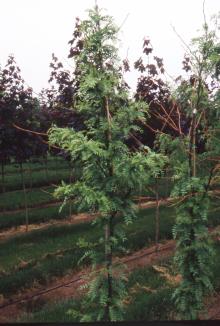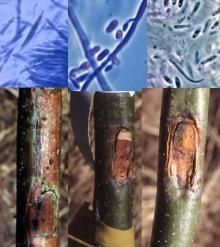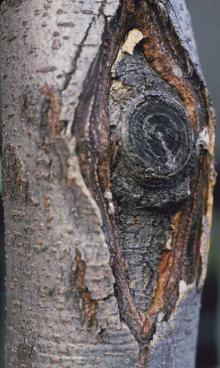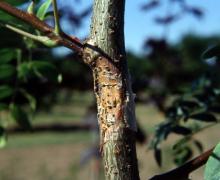Cause Several fungi have been associated with a canker problem in the Pacific Northwest. Fusarium spp. and Phomopsis sp. have been associated with canker problems in nurseries. Nectria cinnabarina has been detected over the years from samples sent to the OSU Plant Clinic.
Thyronectria austroamericana (asexual: Gyrostroma austroamericana) has not been reported in the Pacific Northwest but is very common in the Eastern United States. Inoculation studies in Illinois found more cankers were present on trees inoculated in September and November than in May or July. Cankers were most frequent on the cultivar Sunburst, less on Moraine and Skyline, and even less on Imperial, Holka, and Shade-master.
Fusarium cankers have been associated with cold events in the fall, early harvest times and wounding. Sawdust storage seems to increase the potential for this disease problem as well. In addition, some cultivars (such as Imperial) are more susceptible than others.
Symptoms These fungi can cause cankers that are not easily distinguished from one another.
Fusarium canker-The earliest symptom is a subtle, orangish bark discoloration that is more sunken as the season progresses. Later, a definite, elongate, sunken, discolored canker is evident. Branches or trunks may be girdled, causing wilting, yellowing, and dieback above the canker. After the bark dies, fungal fruiting bodies (sporodochia) break through the lenticels. These sporodochia are football-shape (elliptical) and are yellow, orange, or salmon.
Nectria cinnabarina-Girdling cankers form on twigs, limbs, and sometimes trunks; then the affected parts die. Cankers appear as slightly sunken areas generally associated with wounds.
Pink-to-orange to reddish-brown fruiting structures (sporodochia) appear in the cankered area in early spring. Sporodochia gradually darken and may appear nearly black. Striking orange-to-red perithecia form on the stroma in late summer and early fall.
Cultural control
- Prune off and destroy infected branches.
- Water occasionally if drought becomes severe.
- Avoid wounds. When limbing nursery trees, use sharp pruning shears instead of knocking off limbs by hand. Careful handling during harvest and storage are also encouraged.
- Maintain tree vigor by proper fertilizing and watering.
- Avoid leaving pruning stubs when removing top growth.
- Avoid pruning in the dormant season.
- Promote winter acclimation by harvesting at later times in the fall.
Chemical control Fungicides have not been successfully used in the bare-root tree industry. Focus on cultural control tactics first before using chemicals.
- Phyton 27 is registered for tree injection but not recommended because its efficacy in the Pacific Northwest is unknown.
Reference Bedker, P. J., and Wingfield, M. J. 1983. Taxonomy of three canker-causing fungi of honey locust in the United States. Trans. Br. Mycol. Soc. 81:179-183.







